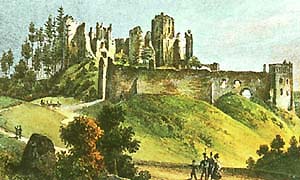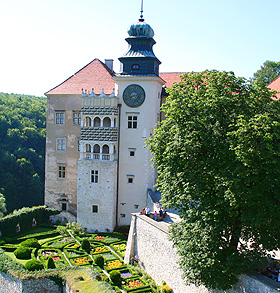Eagle Nests’ Trail, connecting several of the most
interesting strongholds, starts in Krakow and has its end in Czestochowa. Sturdy hikers can cover the
distance of 164 km following signs – a red horizontal bar
sandwiched between two white ones – painted on tree trunks,
telephone poles, pylons, etc. It begins at Krakow’s Osiedle
Trzydziestolecia (os. XXX-lecia) residential area, namely by
its bus station. The route runs via Pradnik Valley (Dolina
Pradnika), Ojcow, Pieskowa Skala, Rabsztyn, Klucze, Bydlin,
Smolen, Pilica, Ogrodzieniec castle, Gora Zborow, Mirow
castle, Potok Zloty, and Olsztyn.
Motorists should best drive first 24 km to the
Ojcow National Park where two nearest eagle-nest castles
are, then to the Rabsztyn, Pilica, Ogrodzieniec, Mirow,
Bobolice, and Olsztyn ones.
Castles and ruins en route from Krakow
Ojcow Castle or rather what remained
of it at a village of the same name in the heart of the Ojcow National Park: the Gothic gate
housing tiny local museum, the octagonal tower of stone, and
ruins of the chapel. Popular as a tourist destination since
the 18th century, the village of Ojcow was a fashionable
health resort through the second half of the 19th century. A
few buildings in the period’s so-called ‘Ojcow style’ last,
e.g. two former hotels: one turned into the Nature Museum,
the other into the post office.
Pieskowa Skala
Castle, called ‘a pearl of the Polish Renaissance’,
at the Ojcow National Park’s northernmost end,
among forests on a hill overlooking the picturesque Pradnik
river valley, dates back to the mid 14th century. In the
16th century it underwent a refurbishment after the fashion
of the north-Italian Renaissance. Since 1970 it has been
home to a European art museum, a branch of Krakow’s
Wawel Royal Castle.
Rabsztyn Castle, overlooking a village of the same
name, replaced a wooden fort of the end of the 13th century.
At the turn of the 17th century a much larger Renaissance
lower castle-palace was built next to the upper
mid-14-century Gothic stronghold. In 1657 Swedes burned the
Rabsztyn castle. Nowadays scenic ruins feature outside walls
up to the second and remains of the Renaissance gate.
Smolen Castle remained in ruins at the village of
Smolen: the Gothic gate, part of the eastern wall with the
sentry gallery, and tall watchtower. The castle hill has
been listed as the landscape park since 1959.
Pilica Castle
at the Pilica village on the Pilica river dates from 1610
and its fortifications from 1650. It underwent refurbishment
in the 18th century when the elegant 10-ha park was added,
and again in the second half of the 19th c. The palatial
four wings contain 40 chambers. The park has been preserved
as a monument of the art of gardening.
Ogrodzieniec
Castle, 2 km east of the 4,600 Ogrodzieniec town,
stands among fanciful limestone crags atop the greatest (504
m) elevation of the Krakow Upland, granting splendid
panorama. In 1545 the grand Renaissance castle-palace of
Krakow’s powerful and fabulously rich Boner family replaced
the king’s mid-14th-century fortress. The castle was
abandoned in 1810, but great deal of its fortifications,
towers, and other structures still can be seen thanks to a
secure tourist route running through the imposing ruins.
Mirow and Bobolice Castles, twin strongholds connected by a ridge, lie
1,5 km from each other. The former was first a wooden fort,
turned into a Gothic fortress in the 14th c., turned a
manor-house in the 16th c., abandoned by 1787. The latter
was knights-robbers’ hideout first, next the 14th-century
king’s frontier fort, then an aristocratic manor between
1500 and 1661 when deserted. In the 21st century the Bobolice castle has been rebuilt and turned into a tourist
attraction.
Olsztyn Castle
above a town-like village of the same name dated back to the
late 13th century but was made a formidable Gothic
stronghold by 1349. In its tower one of King Casimir III the
Great’s rebellious barons was starved to death in 1360. In
the mid 15th century the fortress was turned into a palatial
residence, ravished by Swede forces in 1656. Its ruins
consist of the 14th-century 35-m-tall round tower (once the
starvation-death dungeon), adjacent remnants of the
residential quarters with a large cave underneath, and the
square watchtower.




